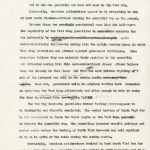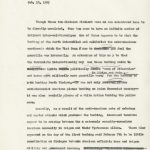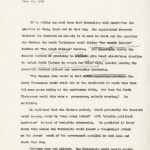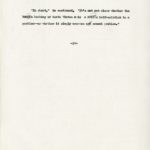1965, February 18, “Distinct Military Wars”
deepe
analysis–1
feb. 18, 1965
SAIGON–There now appears to be 2 1/2 distinct military wars in Viet Nam.
However, reliable sources here believe that even if these violent, visible milita ry actions ceased, the Communists could still through invisible political subversion “take over the country without firing a shot.”
Of the 2 1/2 military wars, the first is the American and South Vietnamese retaliatory aerial bombing raids against the Hanoi regime. These raids are interpreted as a means to conventionalize the war.
Running parallel to this war, and of a different dimension and intensity, however, is the gnawing guerrilla war in the villages without within South Viet Nam. The Viet Cong Communist guerrillas are considered here to be well on the way to winning the guerrilla war. They are considered to control more of the villages in South Vietnam more of the time than does the government–but they do not control the district towns and urban centers as completelysolidly as does the anti-Communist side.
deepe
analysis–2
feb. 18, 1965
But to win the guerilla war does not mean to win Viet Nam.
Conversely, American policymakers appear to be attempting to win or save South Vietnam–without winning the guerrilla war on the ground.
Between these two seemingly paradoxical wars lies the half-war–the capability of the Viet Cong guerrillas to maxamiztem escalate the war internally by moving into the mobile war phase, mhm semi-conventionalizing the ground war–by moving into the mobile warfare phase in which Viet Cong battalions are pitched against government battalions. Some observers believe they can maintain their position in the guerrilla war withoutas moving into this semi-conventional phase; others believe they are already in that phase and that the most intense fighting of t yet of the internal war will erupt in the coming months. move into this sphere. Thus far, the government units in setpiece battles have succeeded in defeating the Viet Cong effectively and often enough to make it risky for them to attempt too often this too-bolding bolding. phase.
The two big wars–the guerrillas versus the bombing raids–appear to be distinctly and directly unrelated. The aerial bombing of North Viet Nam is not considered to force the Hanoi regime or the Viet Cong guerrilm to forsake the guerrilla war. The guerrillas launched massive sabatoge and mortar raids before the bombing of North Viet Nam–and may well continue to do so in spite of the raids during the coming months.
Conversely, American policymakers decided to bomb North Viet Nam for reasons other than the guerrilla war–the Tonkin Tu Gulf incident–and it is still unclear to observers and officials here whether they would again launch retaliatory raids in the future.
deepe
analysis–3
feb. 18, 1965
Though these two distcint distinct wars ar are considered here to be directly unrelated, they doe seem to have an infinite number of indirect inter-relationships. One of these appears to be that the bombing of the North intensified and solidified the anti-American sentiments which the Viet Cong f use to feudmmgem gue fuel the guerrilla war internally. An extension of this ma y be that the Communists internationally may use these bombing raids to feul pliimm ignite future politically futurein the future “wars of liberation” and hence more militarily more guerrilla wars in Africa and Asia. For the bombing of t in bombing bombing North Vietnam, It was not only American planes anti-Communist American planes bombing an Asian Communist country–it was also, racially, planes of a white nation bombing the yellow race.
Secondly, as a result of the anti-American acts of sabatoge and mortar attacks which provoked the bombing, increased tensions appear to be arising between the t extremely security-conscious American community in Saigon and their Vietnamese allies. There also appeared on the day of the first bombing raid February 7th to be little coordination or dialogue between American officials here and Saigon military and government leaders. Officially, Vietnamese police are briefed and were to fly on one Lt. Gen. Nguyen Khanh, commander-in-chief of the Vietnamese Armed Forces, for example, leaped spoke only seven-minutes with Presidential Assistant MacGeorge Bundy and American Milita[ry?]
(More)
deepe
analysis–4
feb. 18, 1965
Commander Gen. William C. Westmoreland—an and the conversation was held only on a hot transport plane in the midst of a Laotianed mortar barraged airstrip. Khanh, though advocating a “Go North” policy for years, was clearly unhappy at the way the decision was reached.
Thirdly, the political bombing of North Viet Nam did produce the political climate which probably facilitated the forming of a new Saigon government–but even then it took ten days for it to be formed. Fourth, the bombing raids against the North did increase the morale of the American and Vietnamese troopers–but they did not raise morale as much as the Pleiku and Qui Nhon incidents decreased it.
“If they Viet Cong can smash Pleiku in one night, they can get an outpost or district the troops in an outpost or district town any night they want,” one reliable observer noted, “and bombing North Vietnam isn’t much of a consolation.”
(More)
deepe
analysis–cdx 5
feb. 18, 1965
It is widely expected here that Communists will react–but the question is when, where and in what way. One experienced observer believed the decision is clearly to be made in Hanoi and the question was whether the North Vietnamese would follow “the smooth Russian” tactics or “the rough Chinese” tactics. His viewpointHe explained [he?] viewed the Russian tactics ofwould be promising to support give Hanoi air-defense missiles to defend North Vietnam in return for solow slow,slowly, quietly pushing the guerrilla warfare and political subversion without any spectacular incidents.
“The Russian line would be that withmsuportmyormxhxthemm the North Vietnamese would still win in the South–but it would take them 2-3 more years ending at the conference table. But then the North Vietnamese would take over a prosperous, orderly country,” he explained.
He explained that the Chinese method, which presumably the Russians would oppose, would be “very rough indeed” with “chaotic political confusion” instead of invisible subversion. He predicted if Hanoi chose this course the Communists would launch a two-pronged attack on the ground south of the seventeenth parallel in both Laos and South Viet Nam.
“Between dawn and mid-day, the Communists could easily muster 25,000 peasants to march on provincial capitals in the northern prove provinces,” he explained “and if they mixed in with them an armed battalion we’d never be able to stop h them.”
deepe
analysis–2
“In short,” he continued, “It’s not yet clear whether the bougin bombing of North Vietnam is a half0s half-solution to a problem–or whether it simply creates aye second problem.”
-30-
Read Previous Article: 1965, February 16, “American Billets and Vietnamese Airbases”
Read Next Article: 1965, March 3, “Fact-Finding Mission from Washington”






